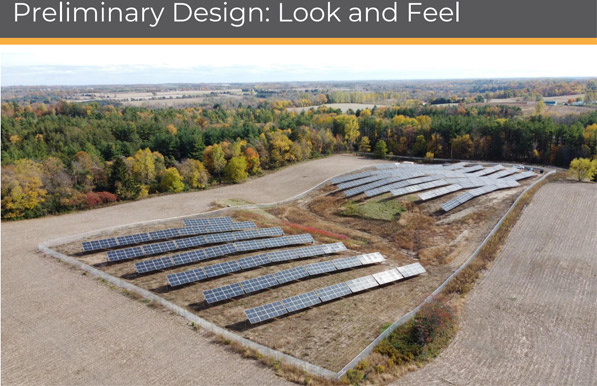Solar and sheep in proposed project on Elmbrook Road; former BESS proposal site
Administrator | Jun 28, 2025 | Comments 0

By Sharon Harrison
Details of a proposed solar energy project on a 105-acre parcel of land in the area of Elmbrook Road and County Road 5 (Green Point) in Prince Edward County were shared with council members at a recent committee of the whole meeting.
The proposal, known as the Elmbrook Agrivoltaics project (agrivoltaics is the practice of using land for both solar energy generation and agricultural use), was outlined by Robert Caputo, with Toronto-based Compass Greenfield Development, and is to promote agricultural activities and solar energy on a single site.
The project, still in its early development stages (and with no government contract yet awarded), has yet to begin to go through the planning process, but could be up and running within four years. The purpose of the deputation was to outline the proposed idea and to share some details along with proposed timelines, and primarily to gain council’s support.
Compass Greenfield has asked for a support resolution from council by the fourth quarter of 2025 and Caputo confirmed they would be back at the July 22 council meeting for an answer in support.
Support from the municipality is required for the project to move forward and for Compass Greenfield to be awarded the contract, something the independent electricity system operator (IESO) procurement process dictates.
After some lengthy discussion around the horseshoe, a motion (by councillor Kate MacNaughton) was passed that the request for support made by Compass Greenfield Development be referred to staff for a report, at the earliest feasible meeting.
“We are not committing to a date when we could come back, and I know it was mentioned that July…, but we want to make sure we have enough time to prepare a fulsome report and have those conversations with the proponent and others,” said Adam Goheen, interim CAO.
MacNaughon further suggested that outreach to indigenous neighbours be done in advance of the staff report coming back to council.
“If that consultation is not done in advance, it’s going to be very difficult for us be supportive,” she said.
In his deputation to council, Caputo outlined what the project is all about, how it will be designed and what it will look like, what the benefits will be to the municipality (including financial), as well as how it will help contribute to Ontario’s electricity needs.
Caputo outlined the reason they are pursuing the project is because Ontario has an urgent need for power.
“The IESO has conducted a look to 2050, there is an expected 75 per cent growth in energy demand, and that’s primarily driven by things like the emergence of data centres, the industrial sector, industrial electrical vehicle production, commercial sector growth, increasing population and electrification.”
He said, as a result, the IESO has launched a second long-term procurement with four windows, with the plan for Elmbrook Agrivoltaics to be submitted as part of the first window for procurement, which has a deadline of October 2025 (with expected contracts in the first quarter of 2026).
 The size of the proposed Elmbrook Agrivoltaics project is expected to be approximately 15.5 megawatt acres on the 105-acre site, which the company is currently leasing from the existing landowner (access would be via Elmbook Road). It was also noted that the project is not located on Indigenous lands (as defined by the IESO Long-Term 2 Request for Proposals).
The size of the proposed Elmbrook Agrivoltaics project is expected to be approximately 15.5 megawatt acres on the 105-acre site, which the company is currently leasing from the existing landowner (access would be via Elmbook Road). It was also noted that the project is not located on Indigenous lands (as defined by the IESO Long-Term 2 Request for Proposals).
Caputo said the company is a long-term owner, developer and operator of solar and BESS projects across Ontario and Saskatchewan, since 2021 (beginning in 2011 with a consulting business).
If the Compass name sounds familiar, Compass Greenfield’s sister company, Compass Renewable Energy Consulting, made a proposal to the municipality in 2022/2023 for a battery energy storage system (BESS) in this area. It failed to seek sufficient interest from the community, or approval from council at that time. For reference, those stories are posted at the end of this article.
“I think the project is certainly better than having a battery storage with lithium that can blow up on you, it’s a lot better than that,” expressed councillor Bill Roberts.
Accompanying the solar panels, would be sheep – 250 of them – who would graze the land of the project site for the foreseeable future, all while solar energy is being generated. It was noted the sheep would maintain the vegetation within a fenced area, where the animals can find shade provided by the solar panels.
A second phase of crop growing/production is expected to be established over the life of the project as Compass Greenfield explores the potential of crop production on the site, if possible.
 Development of solar on private lands is consistent with Prince Edward County’s commitment to mitigating climate change, it was noted.
Development of solar on private lands is consistent with Prince Edward County’s commitment to mitigating climate change, it was noted.
“As well, the Prince Edward County official plan states it support towards solar development: Section 3.4.7 of the official plan, energy generation and transmission states, ‘the municipality does support compatible alternative energy development, including solar’.”
Roberts said his understanding of the official plan criteria is that on-farm diversification must be that the diversification must be secondary to the actual farming.
“It looks to me that sheep are imports to that land, and that is not currently the farm use of that land.”
Caputo confirmed that the planning department has advised that with a property designated as rural, there isn’t a restriction to a secondary use, like in this case, with sheep.
“I am still a bit concerned about the primary use of the land being farming and agriculture, and guarantees that is in fact the case through the lifespan of the entire program,” added Roberts,
While the panels would be spaced 25-feet apart, Caputo was unsure how many panels would be installed on this site, but said it would be around 20,000, adding it would depend on the wattage of each panel, which can vary. He said right now, the panel wattages are 60 watts, but said next year they could be 700-plus watts, which could reduce the overall number of panels.
MacNaughton said she thought it was a “really great location” for the project and asked about the impacts of having panels on a property for that length of time, and what happens when the panels are eventually removed, specific to impacts on the land below, such as plastics run-off or danger of pollution.
Caputo said he was not aware of any such impacts, but reminded that when or if it was decommissioned, the site would be returned to its original condition.
Aside from the grazing sheep, the benefits to the community if the project were to proceed, according to Compass Greenfield, include a stronger local energy grid, a diversified income stream for landowners in terms of lease payments paid to the landowner by Compass Greenfield, short-term job creation (from construction) and therefore economic stimulus, along with an increased tax base to the municipality.
An agreement to commit to pay the municipality $1,000 per megawatt acre annually (once commercial operation begins) is also part of the proposed deal.
Roberts touched on the benefits to the community, especially in terms of the provision to energy to Prince Edward County.
“This energy project feeds directly into provincial grid, so there is no particular benefit in terms of the County, is that right?” asked Roberts.
“In terms of an energy production perspective, that is correct,” replied Caputo, who confirmed how the energy goes to the Picton distribution station and is distributed across Ontario.
Roberts further asked, that in the event of a grid failure or a major outage, would the fact that it is run through the Picton station (before being distributed across the province) benefit the County. Caputo said he didn’t believe so.
Addressing the community benefits to going ahead with the project again, and particularly the financial contribution to the municipality annually of $1,000 per megawatt acre, Roberts questioned the $12,000 or so (per annum) payment (Caputo confirmed it was $15,500).
“It seems a little token-ish to me, very slim in terms of…. you reference County Road 49, that’s a $50 million project, so, a $12,000 contribution to the community is pretty small,” said Roberts.
Councillor Janice Maynard addressed the issue of decommissioning the facility, and how the company (which is responsible for decommissioning the site) can look 30-plus years into the future, and how those securities are calculated. She also noted that it would not be until mid-way through the contract that securities would be put in place.
Caputo said the securities would be calculated by a third-party engineer who would determine the cost to decommission the site, and that amount would be posted via a security.
“We wouldn’t even see those for 15 to 20 years from now,” expressed Maynard. “If your company is sold or ceases to exist, or for whatever reason is not around in 30 or 40 years, are you saying it then becomes the landowner’s responsibility?”
Caputo confirmed that would be the case. When asked by Maynard if he had any idea of the cost currently to decommission a site of this size, Caputo said he did not.
“With this asset, the plan is to own it long-term and ultimately extend its life as we can, either through a re-power or a re-contracting through the IESO, but in the event of decommissioning, it would be our responsibility to decommission the facility,” Caputo confirmed.
He said, they will also be offering a decommissioning security to the landowner (their landlord) in which they would be responsible and would use that security in the event that they would need to draw on the funds to decommission the facility if Compass Greenfield were unable to do so.
Compass Greenfield indicate they are an industry leader in renewable and clean energy development across Ontario, and claim a track record of success, having developed over 100 renewable energy projects in Ontario, representing over 100 megawatts in the last six years, and supported the development of over 2,000 megawatts.
There would be five stages to the process, including pre-contract (contract award), development, constructions, operation and decommissioning.
In terms of timelines, the company proposes to submit a proposal by Q3 2025, with contracts to be awarded in Q1 2026, with construction and installation to happen in 2027/2028, and commercial operation to begin in 2029/2030. It is expected to be in operations for 20-plus years (up to 30 years), with the site to be decommissioned in approximately 2051.
Caputo explained this piece of land was chosen for a proposed solar energy project because it is located on designated rural lands (and not prime agricultural land which restricts solar development according to the provincial policy statement). They also state the local transmission station supports the project’s capacity. It was also confirmed that they plan to connect the property to existing Hydro One infrastructure along County Road 49.
Roberts raised the company’s indigenous and community engagement plan.
“I remark that your reference to indigenous engagement is both last and also at request, it sounds very passive to me, almost as if it’s a procedural box that needs to be ticked off,” suggested Roberts, who suggested the company consider being more pro-active.
Caputo answered by saying they do want to be pro-active, acknowledging the importance, and once they had a contract in place, they would then reach out to indigenous communities, “as that’s when a project becomes a real project”.
While Compass Renewable Energy were not successful in bringing BESS to the County, they did secure Ontario contracts in Windsor, Almonte and North Glengarry. In addition to actively developing these battery energy storage projects, Compass Greenfield manages the operations of eight solar facilities, four of which are in Ontario.
It was noted that a community meeting was held last week [this media was not aware, nor invited], where only six or seven people attended, largely due to notices only being sent to those neighbours within 500 metres of the site (and there are few residences in the area). Councillor Roy Pennell asked that a general meeting for the public be held since the project affects the wider community.
Council opposes largest battery energy storage system; will consider staff report on smaller sites
Public expresses concerns about proposed battery energy storage facility
Filed Under: Featured Articles
About the Author:
































